8 Trees You Can Have As Houseplants
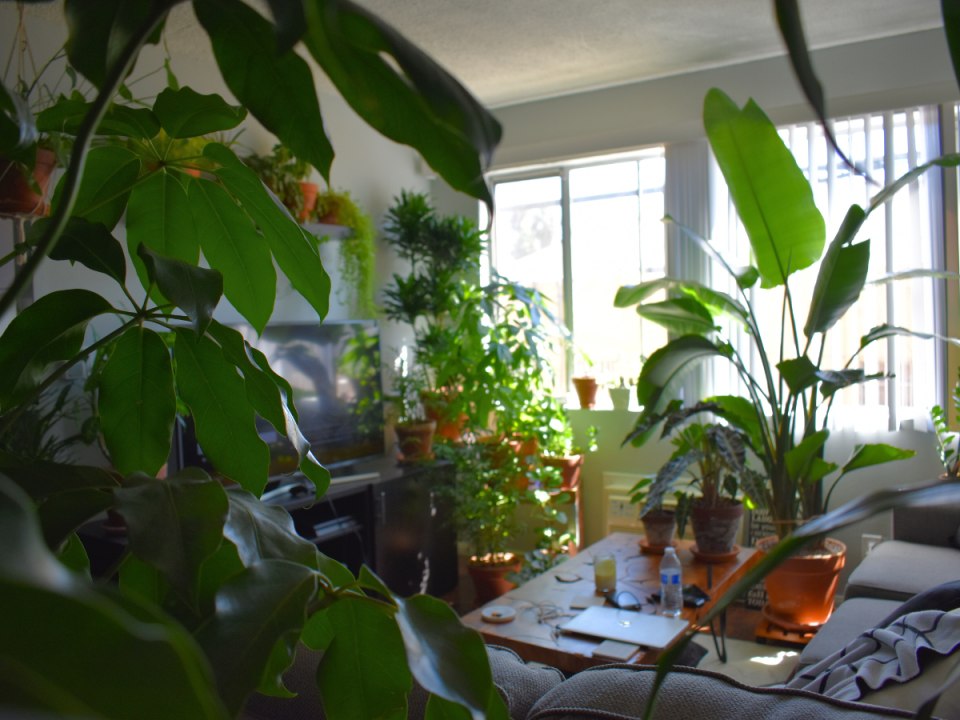
Alright tree lovers – who here hasn’t dreamt of a beautiful mature tree taking central stage in their home? Well fortunately there are plenty of trees that will happily do just that! We've listed some of the best house plants to satisfy the dream of bringing the forest home.
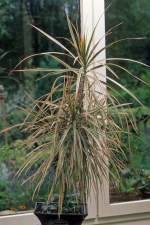
Dragon tree
Most trees that don’t mind the dry, warm environments of our homes unsurprisingly hail from warmer climates, and dracaena marginata is one such tree. The dragon tree can grow up to 30 feet tall in its native Madagascar. In your home, it will reach a petite 6 foot, and isn’t very demanding.
In return for pretty low effort maintenance, it will help remove formaldehyde from your air, as shown in a NASA Clean Air Study.
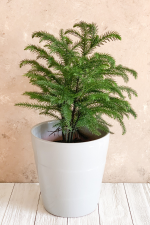
Norfolk Island Pine
Araucaria heterophylla comes to us in the form of a cute conifer from an island not far from New Zealand. We have one in our office which brings us a lot of joy as it looks very similar to the pine trees we plant – but it is not a true pine, despite its name saying otherwise.
For most of the year it makes for a strikingly green indoor tree that will happily thrive in your home so long as it gets good light and isn’t left to dry out. Then during the holiday season it doubles up as a very eco-friendly Christmas tree – hurrah!
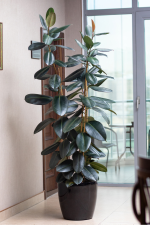
Rubber tree
Ficus elastica is another with a deceiving name, it doesn't get used in the commercial production of rubber nowadays, but its latex sap was once a core ingredient.
The rubber trees available for houseplants are cultivars, such as ‘Robusta’, and do require regular misting, which can be done using a spray bottle of water. But with a bit of care, the rubber tree will reward you with beautiful big leaves and can grow well above 6 feet, giving any room a jungle vibe.
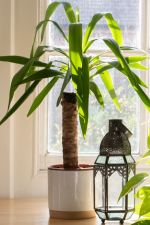
Spineless Yucca
Yucca elephantipes (also known as yucca gigantea) are another good low maintenance option. Its palm-like leaves that grow directly out of the trunk bring to mind hot deserts, maybe a swimming pool and a refreshing cocktail (if that’s the vibe you’re going for).
In the right conditions, it will reward you with beautiful white flowers and be with you for over 20 years - we’ve heard tales of them living well past 30!
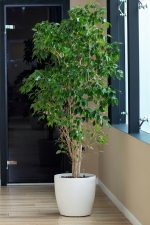
Weeping fig tree
Another tree from the ficus family, but worth mentioning because of how tree-like it looks. Ficus benjamina is not as sunlight-demanding as others, but does benefit from higher humidity. It would do well in a bathroom that gets some light, but not direct.
When happy, this ficus bushy look really does bring the outside inside, though it can get a bit moody with sudden changes and drop these leaves.
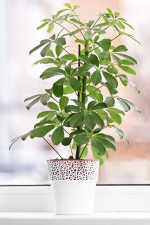
Umbrella Tree
Varieties of schefflera can be grown as a shrub or a tree, and make for pretty low maintenance house plants. Their unusual palmate leaves will give any area a tropical vibe, and can grow up to 8 feet tall if their pot is continuously upgraded.
They are most commonly known as schefflera in houseplant shops, but a reassigning of the genus has moved this plant over to the heptapleurum genus. But schefflera is more fun to say, so the name has stuck!
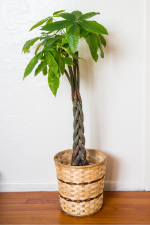
Money tree
Pachira Aquatica may not finally fulfil that wish of ‘money grows on trees’, but it will provide a display of glossy green leaves, and it often comes with a braided trunk, which after a bit of googling, seems feasible to maintain!
It’s a tropical wetland tree often growing in the swamps of Central and South America, but in our homes it prefers its soil to dry out a bit between watering. No, we don’t understand it either.
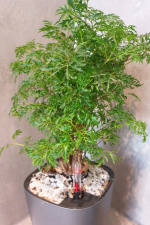
Aralia Ming
This dwarf tree, also known as Polyscias ming, grows very slowly, but can eventually reach about 6 feet tall. It has a gnarled-looking trunk and elegantly dividing leaves, which is the payoff for being a slightly more demanding plant, requiring high humidity and specific soil needs.
As a small plant used to living under other plants, it doesn't mind a bit of shade. In fact its name Polyscias means many-shaded - though that is more in reference to its foliage, but it's a fun way to remember its Latin name.
Tree house plant care FAQs
What does it mean to let the soil dry out?
Good question, and the answer usually is not to let it completely dry out, usually just the top two inches. But even then, this does depend from plant to plant. Keep an eye on your plant and eventually you’ll learn what it needs, but don’t follow generic advice like ‘water every week’ as overwatering will often quickly lead to root rot.
When do you feed house trees?
Again, this does depend on the plant, but eventually the soil your tree came in will be depleted of nutrients and will need feeding. Check up online what your plant needs, but monitor your tree closely as overfeeding can cause stress.
What does direct light mean?
This means sunlight directly shining through a window, something most houseplants simply won’t tolerate. Most often this is because in their native habitat they’re found on the floors of rainforests. The best thing to do is put plants that love direct sunlight near that window (such as cacti and some succulents) and move other plants away from it.
Are there any plants that can survive a room with no light?
The internet will tell you yes, but in reality, all plants need light, as it’s where they get their food from. But some plants will tolerate surprisingly low light, just take those ‘these plants don’t need sunlight’ blogs with a pinch of salt!
Are any of these plants toxic?
Yes! Please research every plant you bring into the home, as a lot of commonly sold houseplants are toxic to cats and dogs, and some even for humans. Large plants such as trees especially need research as they are too big to put out of the way of curious hands (or paws!)
Do houseplants clean the air?
Most plants filter out harmful pollutants, and whilst there have been some great studies demonstrating houseplants' effectiveness in controlled environments, unfortunately, the same can't be said for our home lives. Our houseplants, even if you have a vast collection, aren't doing anything too meaningful. But we're optimists here at Trees for Cities, and if houseplants are actively filtering some air, isn't that better than nothing?
Are houseplants bad for the environment?
As an environmental charity, we couldn't not address the elephant in the room. Everything we do impacts the world we live in, even indoor and outdoor gardening. Houseplants are low on the list of harmful human activity, but it doesn't mean we shouldn't consider ways to be a bit more mindful when making our purchases.
The best option is to get cuttings from someone you know and grow the plant yourself. If that isn't an option, just making sure you're researching the right plant for you, and then looking after it well. A lot of plants get bought, die, discarded, replaced. If you're able to keep that yucca or ficus growing for several years - that's as close to an eco-friendly purchase as any!
You're here because you love trees...
...and we exist because we need more of them. Over 84% of the UK population live in urban areas, and we believe everyone deserves access to trees.
Support our work today to bring nature into our towns and cities - let's make tomorrow a greener world.
Donate to Trees for Cities and together we can help cities grow into greener, cleaner and healthier places for people to live and work worldwide.
Donate